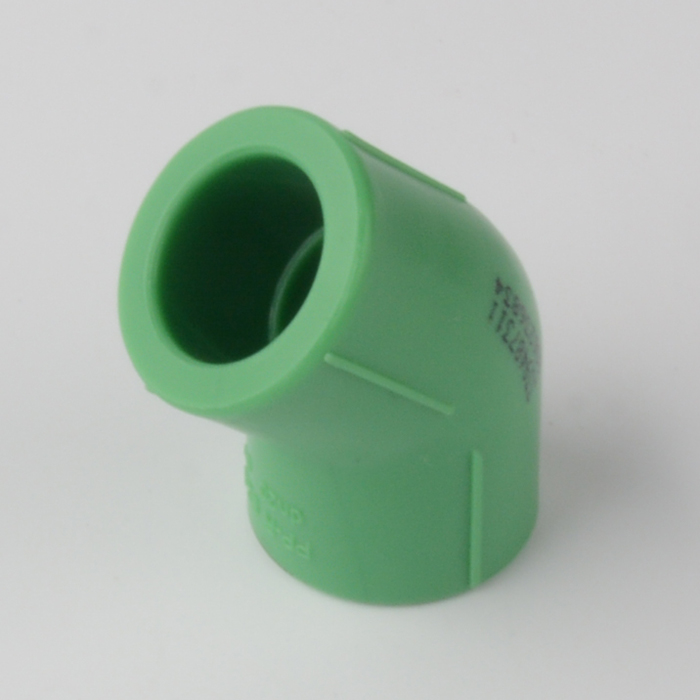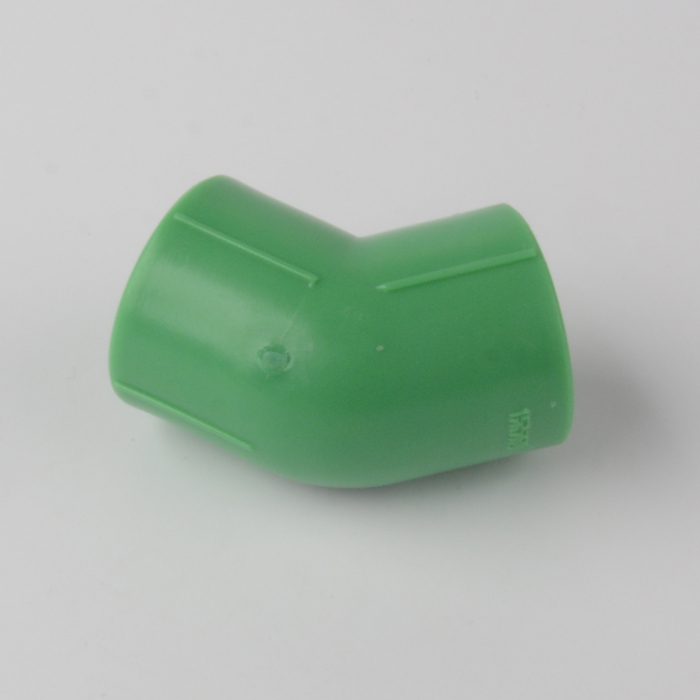








Basic Information
1.Altering Pipe Orientation: Akan Polygon 45° elbow, a key part of the PPR piping system, is used to alter pipe orientation at a measured angle. When set against Akan Polygon 90° elbow, it facilitates a more gradual directional shift. This feature makes it particularly suitable for complex pipe layouts where precise flow direction is needed.
2. Minimizing Flow Impedance: In fluid dynamics terms, Akan Polygon 45° pipe elbow creates less turbulence and vortex formation than Polygon 90° version. This leads to more streamlined flow, lower energy consumption, and aligns with the goals of an energy - saving piping system. The smooth flow dynamics contribute to long - term efficiency in water transmission.
3. Spatial Adaptability and Visual Appeal: Within restricted settings like building interiors and industrial areas, Akan Polygon 45° elbow allows for versatile and space - efficient pipe arrangement. It can conform to intricate spatial demands without requiring excessive room. This adaptability is crucial in modern construction where space optimization is as important as aesthetic considerations.
4. Setup and Servicing: The PPR material, commonly used for 45° elbows, allows for simple PPR pipe installation via heat fusion connection technology. This technique ensures a robust and watertight joint. The ease of installation and maintenance reduces downtime and labor costs, making it a preferred choice for both residential and commercial applications.
Description
Name | PP-R Pipeline |
Material | Polypropylene |
Diameter | 20mm-160mm |
Series | S2.5 |
Brand Name | POLYGON |
Certification | AENOR/DVGW/WRAS CE/ISO9001/ISO14001 |
Welding Way | Hot Melt Connection |
Packing | Cartoon |
Pressure | High Pressure |
Temperature | 0℃-95 |
Service Life | 50 years |
Delivery Time | 30 days after deposit |
Specification

Application Field
Cold and Hot Water Supply: Polygon PPR piping system, composed of Polygon PPR pipes and fittings, is ideal for home and urban water supply. It offers safety, hygiene, easy installation through heat fusion connection technology, and long service life, meeting the cold and hot water supply needs of residential and commercial buildings.
Heating Systems: Polygon PPR pipes are extensively used in floor heating, wall panel heating, and radiant heating systems. Their heat resistance allows them to withstand high - temperature hot water in heating systems, ensuring even heat distribution and improving heating efficiency. Akan Polygon 45° pipe elbow in the system enables more flexible pipe layout, adapting to various heating system designs.
Building Water Supply and Drainage: Polygon PPR pipes and fittings are widely applied in building water supply and drainage systems. Their smooth inner walls prevent scaling, and their corrosion resistance effectively avoids pipe blockages and corrosion issues, guaranteeing the long - term stable operation of water supply and drainage systems. The energy - saving piping system feature of PPR materials also contributes to reducing overall building energy consumption. Proper PPR pipe installation ensures the optimal performance of these systems in different building environments.
Hot Melting Guide

Q&A
1.How many pipe series are there in Poly PP-R pipe materials based on size?
Akan Polygon Poly PP-R pipe materials come in five pipe series based on size: S5, S4, S3.2, S2.5, and S2.
2. How is the acid and alkali resistance of Polygon PP-R pipe materials?
PP-R pipes and fittings have good acid and alkali resistance. At room temperature, they can withstand weak acids and weak alkalis, making them suitable for various chemical environments in building water supply and drainage systems.
3. What is the normal operating temperature range for Polygon PP-R pipe materials?
For Polygon PP-R cold water pipes, the water medium temperature should not be lower than 0°C. If it falls below 0°C, anti - freezing measures should be taken. For Polygon PP-R hot water pipes, the maximum operating temperature for the water medium is generally not higher than 70°C. Temperatures above this can significantly affect the strength and service life of the pipes, so it's crucial to maintain appropriate temperatures for optimal performance.
4.What are the main connection methods for Polygon PP-R pipes?
The main connection methods for Polygon PP-R pipes are hot - melt connection and electrofusion connection. Both methods are suitable for connecting Polygon PP-R pipes and fittings, ensuring a strong and leak - proof joint in the Polygon PPR piping system.
5. What is the temperature range for hot-melt connection of Polygon PP-R pipes?
Hot - melt connections should be carried out within a temperature range of 260±10°C, following the welding process specifications in technical standards. In actual construction, the heating time and temperature should be determined by experiments to ensure a strong connection. This heat fusion connection technology is a key factor in the reliability of the entire Polygon PPR piping system.
6. What are the key points to note during the Polygon hot-melt connection of PP-R pipes?
Hot - melt connections involve four key elements: material quality, time, pressure, and temperature. All factors related to these elements can affect the connection quality. In addition to following construction standards, the following points should be noted during Polygon PPR pipe installation:
(1)Check whether the material and specifications of the pipes and fittings meet the construction requirements. Inspect the appearance quality and remove any oil or impurities from the product surface.
(2) Check if the construction site voltage is normal, and inspect the hot - melt machine for any leakage or malfunction in the control device.
(3)Check if the non - stick coating of the melting machine is intact. Any peeling can significantly affect the welding quality. If the coating is damaged, replace it promptly.
(4)When the construction environment temperature is below 5°C, Polygon pipes are prone to breakage. Be careful with cutting and handling, and appropriately increase the welding temperature and insertion time.









